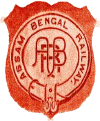

With the development
of Calcutta Port,
EIR controlled Calcutta’s link with
the rest of India but it was desperately looking for a direct rail access to the
Port. This was achieved when the EIR joined hands with the Eastern Bengal Railway (EBR).
(CLICK
ON THE THUMBNAILS TO ENLARGE PICTURES)
The Eastern Bengal Railway (EBR), which was formed in 1857, opened a single line from Calcutta to Ranaghat in September 1862, which was extended to Kushthia (now in Bangladesh) two months later. The Calcutta terminus was a tin-roofed station room at Sealdah.
The linking of EIR and EBR was achieved when the Jubilee Bridge linking Hooghli (Bandel) and Naihati was opened on 21 February 1887. Freight traffic from upper India could now run through to the Port, a charge being paid to the EBR for the use of its tracks.
In 1882-84, the Bengal Central Railway Company opened a line from Dum Dum to Khulna and another from Ranaghat to Bongaon.
Subsequently EBR was taken over by the state and absorbed the C. & S. E. Rly. and several other small private and state railways in East and North Bengal, converting all of them to broad gauge. By 1926, EBR had a BG line from Calcutta to north Bengal and catered to the entire industrial and suburban needs on the eastern side of Hooghly around Calcutta.
In 1932, the Calcutta Chord Railway constructed the link from Dum Dum to Dankuni over the Willingdon Bridge.
Meanwhile, the Assam Bengal Railway (ABR), which was formed in 1892 to serve
British owned tea plantations in Assam, extended its lines from the interior of
Assam to Chittagong port and developed many interchange points, including
riverine transshipment points with EBR.
in Assam, extended its lines from the interior of
Assam to Chittagong port and developed many interchange points, including
riverine transshipment points with EBR.
In 1942, EBR and ABR were merged to form the Bengal and Assam Railway (B & A Rly.) with head quarters in 3 Koilaghat Street, Calcutta, presently the Old Koilaghat Office of Eastern Railway.
When the country was partitioned in 1947 to create Pakistan, the B & A Rly. was split up between India and Pakistan. The truncated B & A Rly had interchange points at Ranaghat and Bongaon with the newly created Pakistan Eastern Railway (PER). This part of B & A Rly. was constituted into a separate division of the present ER called Sealdah division and Calcutta station later renamed as Sealdah station.
A committee, appointed by the Pakistan government to review the performance of East Bengal Railways in 1949, lamented that the railway’s vital units of operation such as Workshop and Technical Training School at Kanchrapara, loco sheds at Calcutta and Chitpur, , Stores depot at Halishahar, S. & T. Workshop and store transit depot at Beliaghata and Traffic Training School at Calcutta, all fell to the share of EIR.